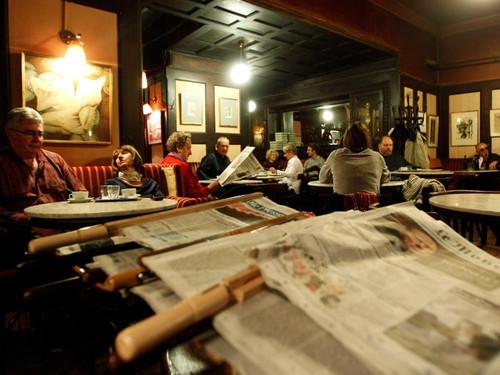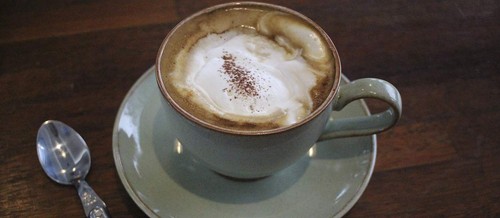 (Photo: Reuters/Lisi Niesner) (Photo: Reuters/Lisi Niesner)
|
Bao Tram: Hi, Gerald! Welcome to VOV’s Cultural Rendezvous! How are you? How long have you been in Vietnam?
Gerald: Thank you for having me, right at the beginning of the Vietnamese New Year of the Tiger.
I came to Vietnam for the first time in 1995 as a member of a delegation from the city of Vienna visiting Hanoi and Vietnam. This visit marked the beginning of the city partnership between the two capital cities, resulting in a still visible project: the road around West Lake under which all the wastewater is collected for treatment to save the lake from further pollution
Today our company NATPOWER Intl. AG is co-investing in sustainable energy generation and energy storage solutions. With our investments in Vietnam and Southeast Asia we help companies to reduce and stabilize energy costs for a long time and contribute to protecting the environment.
Bao Tram: As we mentioned in our intro, cafés are an essential part of daily life of the Austrian people, especially those in Vienna. How did Viennese coffeehouse culture begin?
Gerald: Coffee was introduced around 1685. After the raising of the 2nd siege of the Turkish on Vienna, an Armenian businessman living in Vienna named Johannes Theodat, who actually was a spy for the monarchy, received the “Hoffreiheit”, a rare privilege, given to him in exchange for his services to the monarchy, which allowed him to sell drinks – in his case, coffee – and not have to pay any tax.
The new drink, coffee, quickly became very popular, was offered in a relatively simple setting which served mainly as a meeting place for gambling and smoking, where women were permitted only when accompanied by a man.
Bao Tram: What are the main characteristics of the Viennese coffeehouse that make it part of the local culture?
Gerald: At the end of the 19th century, it developed into an institution of a particular kind, found nowhere else in the world other than Vienna, the capital city of the Austrian empire and the most important city of the monarchy – like Prague in today’s Czech Republic, Budapest in today’s Hungary, Lviv in today’s Ukraine, or Trieste in today’s Italy – where one could buy a cup of coffee and sit for hours talking, writing, playing cards, reading and writing letters, or reading an endless selection of newspapers and magazines.
Coffeehouses, until today, have served as a place where you can go to be seen and meet people, discuss business, or just relax. Besides the endless variations of coffee and a variety of cakes and pastries, you can also get small dishes. While waiting for somebody or just being on your own, you have an endless selection of magazines and newspapers available, free of charge, for reading there.
 “Vienna Melange”, a local favourite that combines German and French words that mean, taken literally, “Viennese mixture”. Often shortened to just Melange on menus and when ordering. (Photo: https://www.tasteatlas.com) “Vienna Melange”, a local favourite that combines German and French words that mean, taken literally, “Viennese mixture”. Often shortened to just Melange on menus and when ordering. (Photo: https://www.tasteatlas.com)
|
Bao Tram: How is the coffee served in these coffeehouses? Is that the same as in other places?
Gerald: Widely known is the “Vienna Melange” – strong coffee with an equal amount of hot milk, topped with hot milk foam and served in a thick porcelain cup.
There are more than 50 different basic varieties of coffee, and many coffeehouses have their own specialties.
Typically, in Viennese coffeehouses the coffee is served with a small glass of tap water on the side.
Bao Tram: From my research, I find that we can’t mention coffeehouses in Vienna without thinking about literary cafés and the coffeehouse’s links to literature. Could you tell us more about that?
Gerald: The heyday of the coffeehouses was at the end of the 19th and the beginning of the 20th century, when the coffeehouses were not only a meeting place but almost the living and working place of intellectuals, artists, scientists, technicians, politicians, and others.
There, they discussed and wrote down their theories, wrote novels, composed music, etc… Among many, a few very famous names were Arthur Schnitzler, Hugo von Hoffmansthal, Karl Kraus, Stefan Zweig, Friedrich Thorberg, Egon Schiele, Gustav Klimt, Oskar Kokoschka, Theodor Herzl, and Leon Trotzki.
Bao Tram: If I’m in Vienna, what are the best coffeehouses should I call at?
Gerald: At the height of the coffeehouses before WWI there were more than 600 in Vienna, according to historical documents. This number diminished swiftly in the period during and just after the 1950s, which was sadly described as the “dying coffeehouses” period.
Today, there are about 1,000 coffeehouses in Vienna, close to 1,000 espresso bars, and more than 200 coffee cake shops.
The most famous coffeehouse for literature was the Café Griensteidl. The most famous coffee shop for the musicians of the 1700s and 1800s was the Café Havelka. Both still exist today.
In the 1st district, the coffeehouses well known to tourists today are the Landtmann, Demel, Sacher, Schwarzenberg, Central, Goldegg, Adam, and many, many more.
Bao Tram: Thank you, Gerald, for telling us some interesting facts about Vienna’s coffeehouse culture.
Gerald: Thank you again for having me. I would like to wish all the friends of VOV5 Chuc Mung Nam Moi for good health, happiness, and prosperity.
Even though I personally prefer Vietnamese “café sua da”, I look forward to welcoming you to Vienna to taste a “Wiener Melange”.